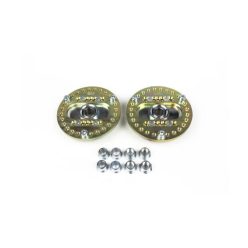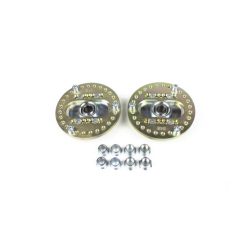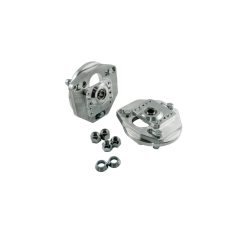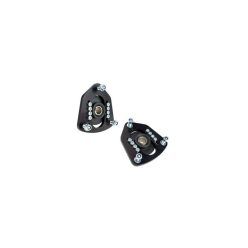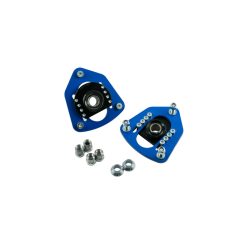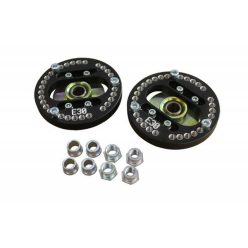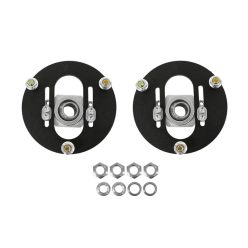Adjustable top mount bearings (camber plates) let you fine-tune front camber and, on many McPherson-strut cars, caster as well. CNC-machined aluminium or steel top mounts with high-strength uniball bearings provide several degrees of adjustment for track, drift and performance street setups. This category includes solutions from well-known brands so you can match steering response, grip and tyre wear pattern to your driving style.
Net price: 123 €
Net price: 123 €
Net price: 123 €
Net price: 157 €
Net price: 137 €
Net price: 98 €
Overview & Key Benefits
Adjustable top mount bearings (camber plates) are one of the most effective tools for tuning front suspension geometry on McPherson-strut cars. By shifting the upper strut mounting point inboard or outboard, you can precisely adjust front camber and, on many kits, caster too. This improves cornering grip, sharpens steering response and helps you target the ideal tyre contact patch for your tyres and usage. On lowered street cars camber plates can correct excessive negative camber, while on track and drift builds they allow you to add negative camber for high-grip cornering and stable high-angle control.
Technical Basics
Most performance camber plates combine a CNC-machined aluminium or high-strength steel top plate, sliding inserts and a motorsport-grade uniball or dedicated bearing. Slotted or oval mounting holes in the plate let the strut studs move relative to the chassis tower, changing the strut angle and therefore the wheel camber angle and, on some designs, caster as well. Quality mounts use large-diameter bearings, hardened sleeves and robust fasteners so they withstand repeated kerb hits, braking loads and high lateral forces without developing play.
Material choice is critical: lightweight aluminium keeps unsprung mass down, while proper surface treatments protect against corrosion. Some road-biased kits use rubber-isolated or hybrid mounts to keep NVH low, but most track and drift solutions rely on solid pillowball top mounts for maximum precision. Poorly made mounts or cheap bearings can become noisy and imprecise very quickly, so camber plates are an area where choosing reputable manufacturers is especially important for both performance and safety.
Selection Criteria
Begin with your suspension layout and goals. On McPherson front ends, adjustable top mount bearings are usually the easiest way to increase negative camber; on double-wishbone systems, adjustable arms often make more sense. For street-driven cars, modest camber correction and a small caster increase will usually improve turn-in without ruining tyre life. Track-day setups may run -2° to -3° of front camber to keep the tyre flat in corners, while drift cars often use even more negative camber and extra caster to enhance self-steer and mid-drift stability.
Wheel and tyre fitment must also be considered. Wider wheels, larger diameters and lower offsets (ET) reduce both inner and outer clearance, so adding negative camber may bring the tyre closer to fenders, suspension arms or anti-roll-bar links. After any significant camber change, cycle the suspension through full bump and droop and steer from lock to lock to check for interference. Scaled markings on the top plate are very helpful for logging and reproducing setups when switching between street and track alignments or testing different tyre models.
Installation & Maintenance
Installing adjustable top mounts requires removing the struts, so it is a good time to inspect the entire front suspension—bushes, ball joints, original top mounts and dust boots. Clean all mating surfaces on the towers, ensure there is no rust or debris, and torque the top-mount hardware to the specified torque values. Lightly lubricate the adjustment bolts and sliders, then lock them securely; loose hardware can allow the camber setting to slip under load, which is both unpredictable and unsafe.
After installation a full wheel alignment (toe, camber, caster) on a proper alignment rack is mandatory, as the new top mounts will have shifted factory settings. Periodically—especially after hard track days or drift events—re-torque all critical fasteners and check the uniball bearings for play or noise. If you notice unusual clunks, creaks or clicks while steering or driving over bumps, inspect the top mounts and strut towers immediately; any cracks, looseness or binding must be resolved before continuing to drive the car hard.
FAQ
Do I need camber plates on a lowered street car?
Often yes. Lowering a McPherson-strut car usually increases negative camber, and adjustable top mounts let you bring it back into a sensible street range—or add just enough extra negative camber to improve grip without destroying tyres.
How much front camber should I run?
For daily road use, around -0.5° to -1.5° of camber is a reasonable starting point. Track-focused cars may run -2° to -3° or more depending on tyre and grip level, while aggressive drift setups can go further and should be tuned carefully based on experience.
Can I skip an alignment after fitting camber plates?
No. Changing the top mount position alters toe, camber and sometimes caster, so a proper alignment is essential for stability, steering feel and tyre life.
Are pillowball camber plates suitable for daily driving?
Pillowball mounts can be used on the street but will increase noise and vibration compared to rubber tops. For mixed use, choose moderate geometry targets, keep damping sensible and record your settings so you can adjust between street and track alignments.
What should I check if I hear clunks from the strut towers?
Inspect all fasteners for correct torque, check the uniball bearings for play and look for any contact between the top mount, tower, arms or brake lines. Any looseness, binding or cracking should be fixed before further spirited driving.


